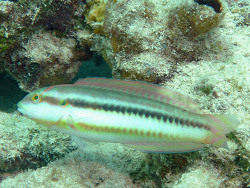Info
Halichoeres bivittatus (Bloch, 1791)
Commonly found in rocky and reef areas in shallow waters. Less common in seagrass beds. Feeds on other fishes and gastropods. Forms leks during breeding.A protogynous hermaphrodite.
Jumping guard
A jumping guard prevents (nocturnal) fish from jumping out.
Wrasses, blennies, hawkfishs and gobies jump out of an unprotected tank in fright if their night rest is disturbed, unfortunately these jumpers are found dried up in the morning on carpets, glass edges or later behind the tank.
https://www.korallenriff.de/en/article/1925_5_Jump_Protection_Solutions_for_Fish_in_the_Aquarium__5_Net_Covers.html
A small night light also helps, as it provides the fish with a means of orientation in the dark!
Synonymised names
Choerojulis arangoi Poey, 1876 · unaccepted
Choerojulis grandisquamis Gill, 1863 · unaccepted
Iridio bivittata (Bloch, 1791) · unaccepted
Julis humeralis Poey, 1860 · unaccepted
Labrus bivittatus Bloch, 1791 · unaccepted
Labrus multicostatus Gronow, 1854 · unaccepted
Labrus psittaculus Lacepède, 1801 · unaccepted
Platyglossus bivittatus (Bloch, 1791) · unaccepted > superseded combination
Platyglossus florealis Jordan & Gilbert, 1882 · unaccepted
Commonly found in rocky and reef areas in shallow waters. Less common in seagrass beds. Feeds on other fishes and gastropods. Forms leks during breeding.A protogynous hermaphrodite.
Jumping guard
A jumping guard prevents (nocturnal) fish from jumping out.
Wrasses, blennies, hawkfishs and gobies jump out of an unprotected tank in fright if their night rest is disturbed, unfortunately these jumpers are found dried up in the morning on carpets, glass edges or later behind the tank.
https://www.korallenriff.de/en/article/1925_5_Jump_Protection_Solutions_for_Fish_in_the_Aquarium__5_Net_Covers.html
A small night light also helps, as it provides the fish with a means of orientation in the dark!
Synonymised names
Choerojulis arangoi Poey, 1876 · unaccepted
Choerojulis grandisquamis Gill, 1863 · unaccepted
Iridio bivittata (Bloch, 1791) · unaccepted
Julis humeralis Poey, 1860 · unaccepted
Labrus bivittatus Bloch, 1791 · unaccepted
Labrus multicostatus Gronow, 1854 · unaccepted
Labrus psittaculus Lacepède, 1801 · unaccepted
Platyglossus bivittatus (Bloch, 1791) · unaccepted > superseded combination
Platyglossus florealis Jordan & Gilbert, 1882 · unaccepted







 Kevin Bryant, USA
Kevin Bryant, USA






























































































